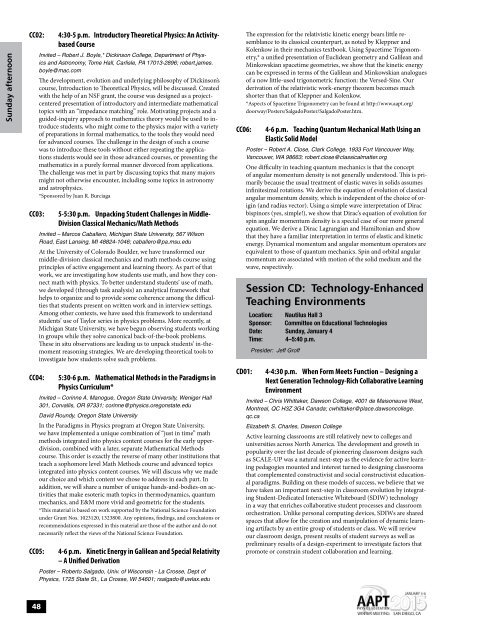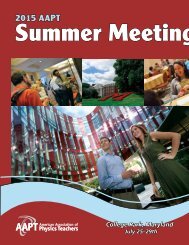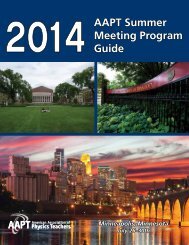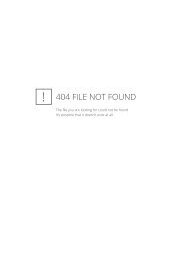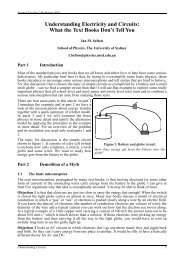final-program-12-23-14-3
final-program-12-23-14-3
final-program-12-23-14-3
You also want an ePaper? Increase the reach of your titles
YUMPU automatically turns print PDFs into web optimized ePapers that Google loves.
Sunday afternoon<br />
CC02:<br />
4:30-5 p.m. Introductory Theoretical Physics: An Activitybased<br />
Course<br />
Invited – Robert J. Boyle,* Dickinson College, Department of Physics<br />
and Astronomy, Tome Hall, Carlisle, PA 17013-2896; robert.james.<br />
boyle@mac.com<br />
The development, evolution and underlying philosophy of Dickinson’s<br />
course, Introduction to Theoretical Physics, will be discussed. Created<br />
with the help of an NSF grant, the course was designed as a projectcentered<br />
presentation of introductory and intermediate mathematical<br />
topics with an “impedance matching” role. Motivating projects and a<br />
guided-inquiry approach to mathematics theory would be used to introduce<br />
students, who might come to the physics major with a variety<br />
of preparations in formal mathematics, to the tools they would need<br />
for advanced courses. The challenge in the design of such a course<br />
was to introduce these tools without either repeating the applications<br />
students would see in those advanced courses, or presenting the<br />
mathematics in a purely formal manner divorced from applications.<br />
The challenge was met in part by discussing topics that many majors<br />
might not otherwise encounter, including some topics in astronomy<br />
and astrophysics.<br />
*Sponsored by Juan R. Burciaga<br />
CC03: 5-5:30 p.m. Unpacking Student Challenges in Middle-<br />
Division Classical Mechanics/Math Methods<br />
Invited – Marcos Caballero, Michigan State University, 567 Wilson<br />
Road, East Lansing, MI 48824-1046; caballero@pa.msu.edu<br />
At the University of Colorado Boulder, we have transformed our<br />
middle-division classical mechanics and math methods course using<br />
principles of active engagement and learning theory. As part of that<br />
work, we are investigating how students use math, and how they connect<br />
math with physics. To better understand students’ use of math,<br />
we developed (through task analysis) an analytical framework that<br />
helps to organize and to provide some coherence among the difficulties<br />
that students present on written work and in interview settings.<br />
Among other contexts, we have used this framework to understand<br />
students’ use of Taylor series in physics problems. More recently, at<br />
Michigan State University, we have begun observing students working<br />
in groups while they solve canonical back-of-the-book problems.<br />
These in situ observations are leading us to unpack students’ in-themoment<br />
reasoning strategies. We are developing theoretical tools to<br />
investigate how students solve such problems.<br />
CC04: 5:30-6 p.m. Mathematical Methods in the Paradigms in<br />
Physics Curriculum*<br />
Invited – Corinne A. Manogue, Oregon State University, Weniger Hall<br />
301, Corvallis, OR 97331; corinne@physics.oregonstate.edu<br />
David Roundy, Oregon State University<br />
In the Paradigms in Physics <strong>program</strong> at Oregon State University,<br />
we have implemented a unique combination of “just in time” math<br />
methods integrated into physics content courses for the early upperdivision,<br />
combined with a later, separate Mathematical Methods<br />
course. This order is exactly the reverse of many other institutions that<br />
teach a sophomore level Math Methods course and advanced topics<br />
integrated into physics content courses. We will discuss why we made<br />
our choice and which content we chose to address in each part. In<br />
addition, we will share a number of unique hands-and-bodies-on activities<br />
that make esoteric math topics in thermodynamics, quantum<br />
mechanics, and E&M more vivid and geometric for the students.<br />
*This material is based on work supported by the National Science Foundation<br />
under Grant Nos. 10<strong>23</strong><strong>12</strong>0, 13<strong>23</strong>800. Any opinions, findings, and conclusions or<br />
recommendations expressed in this material are those of the author and do not<br />
necessarily reflect the views of the National Science Foundation.<br />
CC05: 4-6 p.m. Kinetic Energy in Galilean and Special Relativity<br />
– A Unified Derivation<br />
Poster – Roberto Salgado, Univ. of Wisconsin - La Crosse, Dept of<br />
Physics, 1725 State St., La Crosse, WI 54601; rsalgado@uwlax.edu<br />
CC06:<br />
The expression for the relativistic kinetic energy bears little resemblance<br />
to its classical counterpart, as noted by Kleppner and<br />
Kolenkow in their mechanics textbook. Using Spacetime Trigonometry,*<br />
a unified presentation of Euclidean geometry and Galilean and<br />
Minkowskian spacetime geometries, we show that the kinetic energy<br />
can be expressed in terms of the Galilean and Minkowskian analogues<br />
of a now little-used trigonometric function: the Versed-Sine. Our<br />
derivation of the relativistic work-energy theorem becomes much<br />
shorter than that of Kleppner and Kolenkow.<br />
*Aspects of Spacetime Trigonometry can be found at http://www.aapt.org/<br />
doorway/Posters/SalgadoPoster/SalgadoPoster.htm.<br />
4-6 p.m. Teaching Quantum Mechanical Math Using an<br />
Elastic Solid Model<br />
Poster – Robert A. Close, Clark College, 1933 Fort Vancouver Way,<br />
Vancouver, WA 98663; robert.close@classicalmatter.org<br />
One difficulty in teaching quantum mechanics is that the concept<br />
of angular momentum density is not generally understood. This is primarily<br />
because the usual treatment of elastic waves in solids assumes<br />
infinitesimal rotations. We derive the equation of evolution of classical<br />
angular momentum density, which is independent of the choice of origin<br />
(and radius vector). Using a simple wave interpretation of Dirac<br />
bispinors (yes, simple!), we show that Dirac’s equation of evolution for<br />
spin angular momentum density is a special case of our more general<br />
equation. We derive a Dirac Lagrangian and Hamiltonian and show<br />
that they have a familiar interpretation in terms of elastic and kinetic<br />
energy. Dynamical momentum and angular momentum operators are<br />
equivalent to those of quantum mechanics. Spin and orbital angular<br />
momentum are associated with motion of the solid medium and the<br />
wave, respectively.<br />
CD01:<br />
Session CD: Technology-Enhanced<br />
Teaching Environments<br />
Location: Nautilus Hall 3<br />
Sponsor: Committee on Educational Technologies<br />
Date: Sunday, January 4<br />
Time: 4–5:40 p.m.<br />
Presider: Jeff Groff<br />
4-4:30 p.m. When Form Meets Function – Designing a<br />
Next Generation Technology-Rich Collaborative Learning<br />
Environment<br />
Invited – Chris Whittaker, Dawson College, 4001 de Maisoneuve West,<br />
Montreal, QC H3Z 3G4 Canada; cwhittaker@place.dawsoncollege.<br />
qc.ca<br />
Elizabeth S. Charles, Dawson College<br />
Active learning classrooms are still relatively new to colleges and<br />
universities across North America. The development and growth in<br />
popularity over the last decade of pioneering classroom designs such<br />
as SCALE-UP was a natural next-step as the evidence for active learning<br />
pedagogies mounted and interest turned to designing classrooms<br />
that complemented constructivist and social constructivist educational<br />
paradigms. Building on these models of success, we believe that we<br />
have taken an important next-step in classroom evolution by integrating<br />
Student-Dedicated Interactive Whiteboard (SDIW) technology<br />
in a way that enriches collaborative student processes and classroom<br />
orchestration. Unlike personal computing devices, SDIWs are shared<br />
spaces that allow for the creation and manipulation of dynamic learning<br />
artifacts by an entire group of students or class. We will review<br />
our classroom design, present results of student surveys as well as<br />
preliminary results of a design-experiment to investigate factors that<br />
promote or constrain student collaboration and learning.<br />
48


